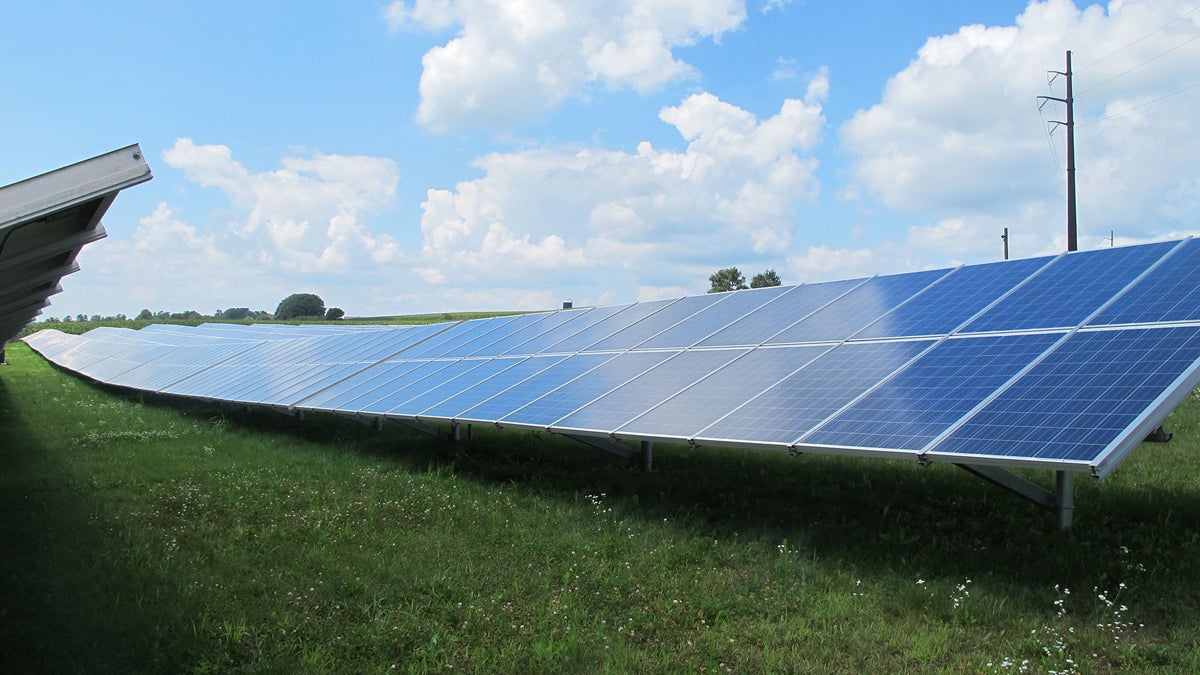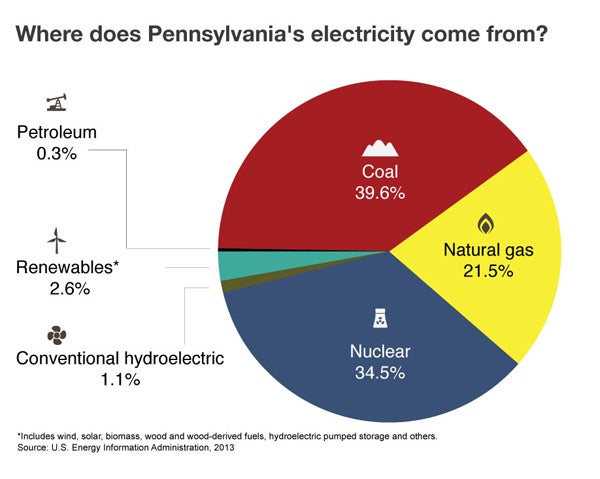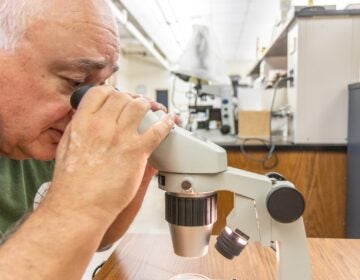Despite ups and downs, solar power still shining in Pennsylvania
Listen
The Hankin Group's two megawatt solar farm in Berks County. (Marie Cusick/StateImpact Pennsylvania)
Standing next to this solar farm in Morgantown, Berks County, you can see the Pennsylvania Turnpike traffic, but the place still feels like a farm. The panels are tucked in behind rows of corn.
[Part four of five]
Pennsylvania is third in the nation for energy production. It’s also in third place for carbon dioxide emissions. As the federal government pushes states to cut emissions that are leading to climate change, StateImpact Pennsylvania profiled five major energy sources: coal, wind, nuclear, solar and oil.
The Hankin Group Solar Farm
Standing next to this solar farm in Morgantown, Berks County, you can see the Pennsylvania Turnpike traffic, but the place still feels like a farm. The panels are tucked in behind rows of corn.
Lance Hillegas is showing me around. He’s the vice president of design and sustainable development with the Hankin Group — it’s the real estate development company that built the business park where we’re standing. In the distance, there’s a factory that makes custom vinyl windows called Viwinco. It gets most of the electricity produced by the panels.
“We supply between 40 and 50 percent of their electric,” Hillegas says, pointing toward the building.
When the Hankin Group built this two megawatt solar farm in 2011, the company was making plans for even more solar installations.
But then things changed.
‘Collapsed might be a strong word’
“At the time it looked like a great investment,” he says. “Since then, the solar renewable energy credit has gone down.”
The solar renewable energy credit (SREC) works like this: under a 2004 Pennsylvania law called the Alternative Energy Portfolio Standard, electric utilities are required to buy eight percent of their power from so-called “tier one” clean sources—like wind and solar– by the year 2021.
If they don’t make the power themselves, they can get it from someone who does; they buy an SREC.
“Back in 2010 when we were envisioning this project and even into 2011, [they] were worth as much as $300 an SREC,” says Hillegas. “Last year, they dipped as low as $20 an SREC.”
What did that do to Pennsylvania’s solar industry?
“Collapsed might be a strong word,” says Ron Celentano who heads Pennsylvania’s Solar Industries Association. “But a lot of the solar industry contractors and businesses either went bankrupt or went elsewhere.”
The funding for Pennsylvania’s Sunshine Solar Program also dried up last year. It was launched in 2009 under former Governor Ed Rendell and provided $100 million in rebates for solar panels on homes and small businesses.
Evan Endres is with the environmental group PennFuture and says the state should do more to support solar.
“We’re not as competitive in this market as other states, because other states have had consistent policy signals and consistent market signals that drive that market,” he says.
‘People want their lights to work every time’
Despite the swings in the solar market, the industry has grown rapidly here and the price for panels has plummeted. Pennsylvania ranks 11th in the nation for installed solar capacity — that’s enough to power about 28,000 homes. But it’s still just a small drop in the bucket of the state’s electric portfolio. Less than three percent of its power comes from renewables like wind and solar. Solar is also an intermittent energy resource, so it needs the sun to shine in order to work.
Jake Smeltz is president of the Electric Power Generation Association — a trade group representing the region’s major electric utilities.
“You don’t want to become too reliant on things which can’t produce until their fuel is available,” he says. “Because people want their lights to work every time. Not 15 percent of the time.”
But solar advocates say emerging energy storage technologies like batteries could help solve that problem, so power could be stored until it’s needed.
At the same time, they’re concerned about policies on the horizon. The Pennsylvania Public Utility Commission (PUC) recently proposed rules around net metering that have ruffled some feathers. Net metering is a benefit to producing more power than you use. So, for example, someone with solar panels on his roof can then sell that extra power back to the grid.
PUC spokeswoman Jennifer Kocher explains.
“It would be to the point where your meter is now going backwards and you are paid for returning that electricity to the grid.”
But the PUC is trying to cap that at no more than 110 percent your historical power usage.
Endres of PennFuture thinks that will discourage investments.
“So you can see how that would be a problem especially for businesses and for homes — the usage changes,” he says. “What if someone gets an electric car? What if somebody does a whole host of whole house energy efficiency measures? What if a business adds a new type of manufacturing process? Energy is not particularly consistent from year to year.”
The PUC has gotten a lot of comments on the proposed rules, but Kocher says it’s not an effort to rain on anyone’s solar array. Instead, the commission wants to make sure people are actually customers who produce extra power –not simply entrepreneurs plugging in, trying to make money off the grid.
She says, for example, if a business wants to double in size and expand its solar array, it can do that.
“You would re-apply for the historical usage and show what you’re using now as opposed to what you were using then, and ask to be net metered according to the new historical usage.”
Back when it built the Berks County solar farm built a few years ago, the Hankin Group got permission for future expansions. Lance Hillegas says, with more panels, it could be producing three times as much power.
“If it becomes attractive again, we would definitely start up and do more solar projects.”
The market for solar may bounce back as the Obama administration pushes states to cut greenhouse gas emissions and find cleaner sources of energy. Under proposed federal rules Pennsylvania will have to cut its carbon emissions 32 percent over the next 15 years.

Credit: Rachel Feierman for NewsWorks/WHYY
WHYY is your source for fact-based, in-depth journalism and information. As a nonprofit organization, we rely on financial support from readers like you. Please give today.




